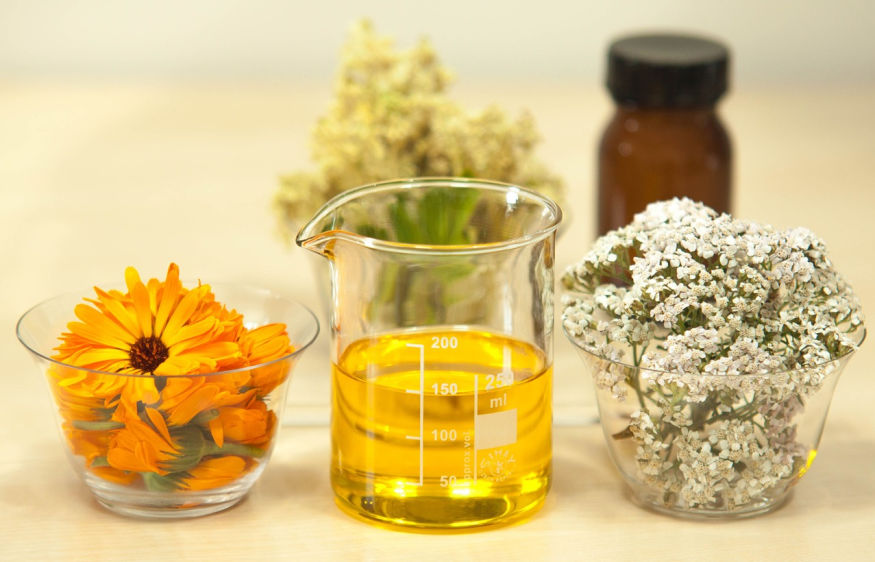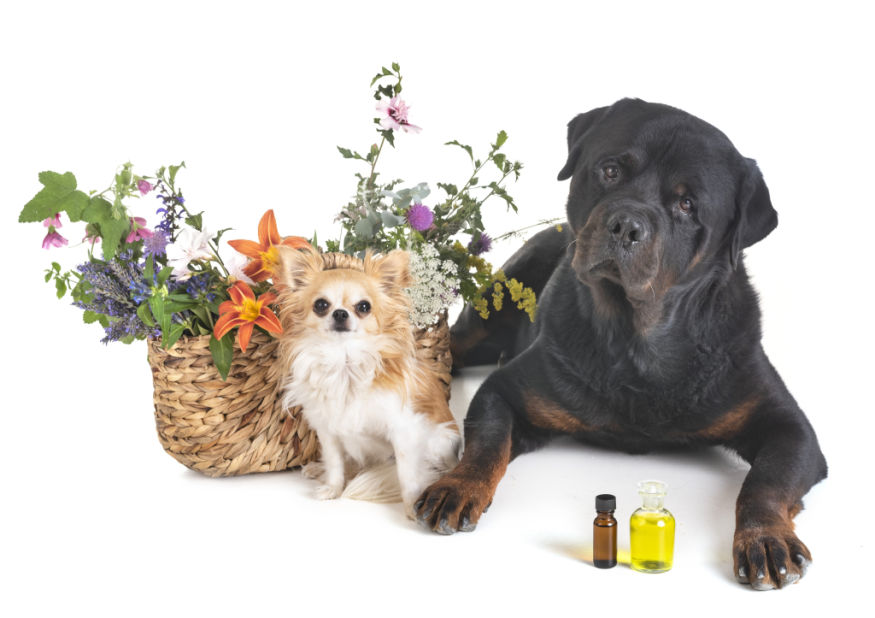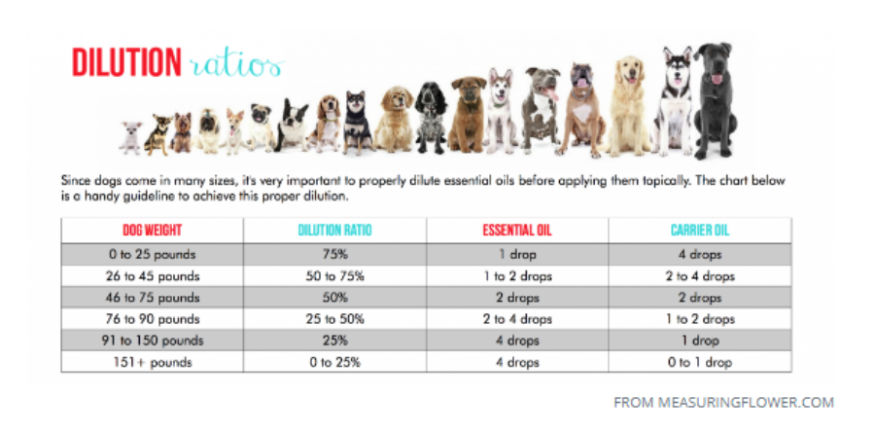
Did you know that some essential oils are bad for dogs?
If you love essential oils as much as we do here, you probably would like to share the love with everyone you know. From your friends and neighbors to your children and pets, you want everyone to reap the benefits.
But, some essential oils are toxic to dogs. By using them, you could inadvertently place your dog at risk of severe side effects.
Some of the adverse reactions your pooch can experience include:
- Impaired central nervous system
- Breathing difficulties
- Skin irritation and rashes
- Lethargy
- Vomiting
- Diarrhea
- Behavioral changes
- Changes in appetite
So, before you start aromatherapy with your best furry buddy, be sure which essential oils are bad for dogs, and which ones are safe.

And, it’s not all bad news. We will also share with you essential oils that are safe for dogs along with some useful tips on how to implement them.
Why Are Some Essential Oils Bad for Dogs?
By now, you might be curious to know why some essential oils are harmful to your pets.
Remember that “natural” does not always equate to “safe.” There are always chances that any person, or pet, can develop an allergy or medical reaction.
Essential oils are powerful plant extracts. That does not mean they are safe for your pet.
Take marigolds, for example. If your dog ingests marigolds, he will likely develop an epic case of diarrhea. So, you avoid planting them where the dog can ingest them to keep your dog safe.
Bear in mind that ingestion doesn’t necessarily mean “eating” the plant. They can also get sick from inhaling too much of it or absorbing it through their fur. In fact, they can even have it on their paws from walking through your garden and lick their paws to ingest that marigold.
Now, imagine you extracted that essence from the marigold into a concentrated oil and rubbed it into their fur in a relaxing massage.
The outcome could be a very sick dog soon after the exposure.

How Severely Might a Dog React to Essential Oils
It’s difficult to say just how poorly one dog might react opposed to another one.
Just as people can be exposed to toxins, some have more violent reactions than others.
Take human exposure to mold, as an example. Two people might be exposed at the same time. One of those people develops asthma and becomes gravely ill while the other person gets a mild cough that disappears on its own in a few hours.

There are many factors that influence the severity of the outcome, including:
- The pet’s age
- How much the dog weighs
- The dog’s overall physical wellness
- Whether the dog is predisposed towards certain conditions
- How closely the pet interacted with the toxin
- Medication interactions
- Pregnancy
- Whether the dog has a short or long snout. Breeds such as pugs and boxers seem to experience more profound effects
Which Essential Oils Are Bad for Dogs?
We have compiled a list of essential oils harmful to dogs to serve as a comprehensive list of EOs that are generally considered by vets to be toxic.
1- Tea Tree Oil

We derive Tea Tree Oil from the canopies of Australia’s Tea Tree, the Melaleuca tree. The leaves of the tree, which are native to Australia and other subtropical climates of the South Pacific, produce the oil that people use to treat various skin diseases, nail fungus, and athlete’s foot. The topical application is ok for humans, but it’s not safe for dogs.
Tea tree oil poisoning in dogs results from the oral consumption or nasal inhalation of tea tree oil in large quantities or concentrated forms. Use leads to side effects from mild irritation to severe damage to the organs, depending on the volume your dog consumed.
The outcome of this exposure can be fatal.
Symptoms of tea tree oil poisoning in Dogs

- Muscle weakness
- Loss of coordination
- Decrease in body temperature
- Depression
- Rash
- Pneumonia
- Paralysis
2 – Pennyroyal Essential Oil
Pennyroyal essential oil, a member of the mint family, contains a compound called Pulegone. Humans benefit from this ingredient, and it’s commonly used in mouthwash, insect repellents, and fine fragrances.
However, while it’s a well-documented flea repellent, it is unsafe for pets. Pulegone is toxic to your dog’s liver and is potentially fatal. Therefore, you should avoid pennyroyal altogether around your dog.
Symptoms of Pennyroyal Essential Oil Poisoning in Dogs
- Coughing up blood
- Bleeding from the nose
- Diarrhea
- Convulsions
- Vomiting
- Loss of consciousness
3 – Peppermint Essential Oil
The fresh minty smell and diverse usefulness of peppermint essential oil make it a favorite of humans. However, this mint is not safe for your pooch. After applying peppermint oil to your dog, he can develop toxicity symptoms.
Peppermint is a common aromatic ingredient used in many pet products. Therefore, you may mistakenly assume it’s safe.
However, in the extremely potent format of its essential oil, it may be toxic.
The Symptoms of Peppermint Poisoning In Dogs
- Lethargy
- Vomiting
- Diarrhea
- Seizures
- Losing consciousness

4 – Wintergreen Essential Oil
Another member of the mint family commonly mistakenly presumed dog-friendly is wintergreen.
Like peppermint and pennyroyal, it’s highly effective as a natural insect killer. But, treating your dog with wintergreen is an enormous mistake that could have dire consequences.
- Lethargic behavior
- Depression
- Vomiting
- Diarrhea
- Seizures
- Loss of consciousness
5 – Pine Oil Poisoning
Pine Oil is a commonly used household cleaner and disinfectant. It is highly toxic to dogs, even in small quantities.
Pine oil negatively impacts the central nervous system, kidneys, and liver.
The cleaning agents are ingested in the gastrointestinal tract and metabolized by the liver on their way to the kidneys, damaging vital organs along the way.
Symptoms of Pine Oil Poisoning in Dogs
- Eyes producing mucus or tears
- Rapid blinking
- Nausea and vomiting
- Muscle spasms
- Pawing at the face, nose, and mouth
- Shallow breathing
- Panting
- Respiratory distress
- Diarreah
- Frequent urination
- Weakness
Pine oil poisoning is pervasive and can lead to death. If you suspect your dog has been exposed, take him for emergency treatment right away.
6 – Ylang Ylang Essential Oil
We know ylang-ylang as the tropifloral aroma that comes from the Polynesian and Pacific islands. It relaxes us and transports us out of our state of anxiety.
However, ylang-ylang essential oil can have the direct opposite impact on your dog.
Dogs have an extremely sensitive sense of smell, and ylang ylang can be too powerful, causing them mild to moderate breathing distress.
Symptoms of Ylang-Ylang Essential Oil Toxicity and Dogs
- Sneezing or runny nose
- Pawing motions at the face, especially around the nose and eyes
- Difficulty walking
- Discharge of tears from the eyes
- Coughing
- Redness around the nose and mouth
- Rash
- Vomiting
7 – Marigold Essential Oil
You use marigolds to accent your gardens each year and perhaps you place them in planters around your deck to keep the mosquitoes at bay.
But, marigolds have mild toxic effects when ingested by your dog.
Your dog’s digestive system is not equipped to break down this plant’s enzymes efficiently, and the outcome of ingesting ranges from mild to moderate levels of toxicity.

Symptoms of Marigold Essential Oil Toxicity and Your Dog
- Drooling
- Irritation of the eyes, discharge, tears
- Sneezing
- Vomiting
- Lethargy
- Diarrhea
- Flatulence
8 – Juniper Essential Oil
Juniper represents an interesting conundrum to the pet owner.
The berries of the Juniper bush, a North American native shrub, are safe for dogs. Indeed, these berries are sometimes an ingredient in natural dog foods or used to treat urinary infections.
However, the bark, needles, and roots are unsafe for pets. Juniper Essential Oil can cause digestive distress from mild to severe.
Because it’s nearly impossible to discern the actual source of the Juniper Essential Oil by the time it’s packages, it’s best for pet owners to avoid it altogether.

Symptoms of Juniper Essential Oil Poisoning in Dogs
- Lethargy
- Flatulence
- Vomiting
- Diarrhea
- Muscle spasms
- Weakness
9 – Sweet Birch Oil
Those who struggle with muscular aches rely on birch essential oil, aka sweet birch, to soothe their painful muscles and to treat symptoms of arthritis.
Using sweet birch oil to try to soothe an arthritic pooch can lead to moderate to severe reactions. In fact, birch essential oil can lead to stomach ulcers, kidney failure, and death.
Symptoms of Sweet Birch Oil Poisoning and Dogs
- Muscle tremors of spasms
- Convulsions and seizures
- Changes in behavior or seems confused
- Lethargy
- Vomiting
- Diarrhea
- Loss of consciousness
- Unable to control bowels or urine
- Eyes appear clouded
10 – Cinnamon Essential Oil

The safety of cinnamon essential oil on dogs is a widely-debated topic.
Cinnamon EO appears both on lists of essential oils bad for dog and lists of EOs which are safe to try. Still, others list cinnamon essential oil as safe for dogs but unsafe for cats.
Use good judgment if you decide to give cinnamon essential oil a try to treat your dog or pass this one up.
Symptoms of Cinnamon Essential Oil Poisoning of Dogs
- Lowered blood sugar
- Changes in heart rate
- Vomiting
- Diarrhea
11- Garlic Essential Oil
Garlic, whether consumed whole or used in essential oil treatment, is toxic to dogs.
Garlic is full of compounds called thiosulphates and disulfides which can damage your pet’s red blood cells. The effect on the blood can last for several days, to the impact might not be evident immediately.
Garlic essential oil can cause severe blood conditions including anemia.
Symptoms of Garlic Oil Poisoning in Dogs
- Pale or yellow gums
- Shortness of breath
- Lethargic behavior
- Shallow breathing
- Flatulence
- Diarrhea
- Vomiting
12 – Citrus Essential Oil
Citrus-derived essential oils are used in packaged flea and tick products for dogs, so pet owners assume that they are safe for essential oil therapy.
Here’s the thing…
In the case of citrus essential oil, too much can be a bad thing. Citrus oil contains linalool, a natural controller. However, when packaged commercially, it is dosed in very specific amounts that are pet-friendly.
A mistake in dosing an at-home mixture can have an adverse impact on your pooch’s health.
Symptoms of Citrus Oil Poisoning In Dogs
- Unsteady on their feet
- Vomiting
- Depressed behavior
- Diarrhea
- Skin rash
- Shaking or trembling
- Decreased blood pressure
- Redness around the nose or mouth
- Pawing at the face or mouth
13 – Yarrow Essential Oil
Yarrow essential oil comes from a perennial herb that’s therapeutic for people, but dangerous for pets.
The culprits?
Yarrow contains three compounds that can cause digestive distress in canines: Sesquiterpene lactones, Monoterpenes, and Glycoalkaloids.
These compounds can wreak havoc on your pup’s gastrointestinal tract, leaving him dehydrated and weak for several days.
Symptoms of Yarrow Poisoning
- Flatulence
- Vomiting
- Diarrhea
- Excessive drooling
- Panting
- Lethargic behavior

14 – Thyme Essential Oil
There seems to be some confusion around thyme essential oil. This unclear ruling on whether or not thyme essential oil stems from the fact that many authorities list it on their rundowns of which essential oils are bad for dogs.
However, the ASPCA lists garden thyme as safe for consumption by dogs, the unaltered, herbal form.
Since thyme essential oil extracts from that same herb, it would seem to be safe. However, once the plant undergoes the distillation process, the output product is more potent.
Long story short, steer clear of thyme as there is much conflicting information with little clear data to back up either argument.
Symptoms of Thyme Essential Oil Poisoning in Dogs
- Excessive drooling
- Tremors and shakes
- Lethargy
- Nausea and vomiting
- Rash or redness, especially around the muzzle
- Pawing the nose or face
15 – Clove Essential Oil
Clove essential oil might be wonderful for soothing your toothache, but it’s a no-go for dogs.
Cloves receive their medicinal properties from polyphenolic compounds. Good news for you, but not for your pooch.
Dogs process these compounds very differently than humans do. Use can cause skin irritation, rashes, and disruption to the digestive tract.
16 – Anise Essential Oil
Another EO whose safety in dogs reveals conflicting information is Anise Essential Oil.
Dogs seem to be drawn to this Mediterranean native plant. In fact, some suggest that this plant be re-named dognip. We even found recipes online for anise dog cookies–using the seeds, not the essential oils.
We found reports, however, that state that anise essential oil is unsafe for use on canines.
Our suggestion is to err on the side of caution, checking with your vet before you administer anise essential oil to your pet.

Symptoms of Anise Essential Oil in Dogs
- Development of rash or redness where administered or around the lips
- Lethargy
- Strained breathing
- Extreme thirst
- Panting
- Muscle spasms
8 Dog Safe Essential Oils
Now that we have explored the essential oils that are unsafe for dogs, let’s take a peek at essential oils that are beneficial to your dog.

Lavender Essential Oil
Is there anything that Lavender Essential Oil can’t do? Just as it’s one of the mose useful essential oils for humans, you’ll find many ways to help your dog.
In dogs, you can use lavender essential oil to treat allergies, burns, skin rashes, insomnia, car sickess, and calm anxious nerves. Additionally, it serves as an effective flea repellant.
Copaiba Essential Oil
Used in traditional Brazilian medicine for centuries, Cobaiba is as helpful for dogs as it is for humans.
Copaiba essential oil supports the cardiovascular, immune, digestive, urinary, respiratory, muscle and nervous system of your dog.
Frankincense Essential Oil
In canines, Frankincense Essential oil Promotes cellular health and supports a healthy immune system.
Additionally, Frankincense Essential Oil may combat specific strains of cancer in your dog. More research is underway in this field, and we will update this article when we find new research.

Petitgrain Essential Oil
Petitgrain Essential Oil, harvested from the stems and leaves of the bitter orange tree, is helpful to canines. It can calm irritability, nervousness and digestive ailments.
This EO is wonderful for dogs with stress or anxiety.
Chamomile Essential Oil:
It turns out that Chamomile Essential Oil is an excellent treatment for canines as well as their human owners.
This EO can alleviate skin irritations, allergic reactions thanks to its powerful anti-inflammatory agents that is an excellent choice for humans and dogs.
Helichrysum Essential Oil
Helichrysum works well for skin diseases such as eczema, insect bites or stings, and other minor skin irritations.
It contains ingredients that serve both as an anti-inflammatory and a mild analgesic (pain reliever).
This dual impact means that it can help repair those skin conditions while lessening the discomfort—increasing the odds of your dog leaving the painful spot alone.
Sweet Marjoram Essential Oil
Sweet Marjoram Essential Oil is excellent for curing bacterial skin infections and can also be utilized to facilitate faster healing of wounds. It has strong antibacterial properties and has both a calming agent and muscle relaxant.
Cedarwood Essential Oil
Cedarwood Essential Oil is a highly effective natural pest repellent. But its usefulness also extends to serving as an antiseptic for wound treatment and expectorant to help recover from kennel cough.
Additionally, cedar oil may help improve dogs who display nervous aggression or shyness.
How to Use Essential Oils On A Dog
Now that you know which essential oils are dog safe, you probably want to give them a try. Here are some tips on how to use essential oils on a dog.
Never put Essential Oils in the Dog Food
First, avoid the temptation to add a drop or two of essential oils to your dog’s kibble or water bowl. Essential oils are harsh to digest!
Surprisingly, while conducting research for this post, I found several anecdotal discussions of these situations. All resulted in their pup becoming…well, as sick as a dog.
Bottom line? Directly eaten essential oils are bad for dogs.
Diffuse Oils for Your Dog

If you are treating your pooch for symptoms of anxiety, stress, or a mild cough, diffuse your dog-safe essential oil using your diffuser.
Apply Essential Oils Topically on Your Dog
For treatment of skin conditions, muscle pain, infections, hair loss, or other conditions, topical application is extremely effective.
Choose a dog-friendly essential oil, and mix three to five drops of EO to 80-90% of your selected carrier oil.
Here’s a handy chart that will help you mix the perfect ratio.

Massage the EO mixture into your dog, focusing on working the treatment under the fur and into the skin. This mixture is terrific as a final rinse during bath time!

Add Essential Oils to their Collar
Want to continuously repel insects? Mix a pest-repelling essential oil like lavender with a carrier oil and dab some onto pooch’s collar for natural pest relief.
Do a Patch Test
Before you begin essential oil treatment on your pet, conduct a patch test, first.
Find a location and place a small spot of your essential oil and carrier oil blend on the pet’s skin. Check the spot in 12 hours to see if it appears irritated. If all appears well, you may begin treatment.
If you see any signs of redness, rash, or irritation, don’t proceed with treatment. Your dog may have an allergy either to the carrier oil or, more likely, the chosen essential oil.
The Best Carrier Oils for Dogs
Not all carrier oils are created equally. Just as you select the premium carrier oils for your use, treat your dog to the finest organic carrier oils for the best results.

The 7 best carrier oils for dogs:
- Coconut oil
- Apricot kernel oil
- Sweet almond oil
- Jojoba
- Olive oil
- Sunflower oil
- Sesame oil
As a person who loves both essential oils and dogs, you hold the responsibility of safe use of EOs on your pet in your hands.
Take the time to carefully research any oils before treating your dog. Once you’re confident of your findings, avoid the essential oils that are bad for dogs and embrace those that are safe for canine use.
Remember that any dog can have an allergy or reaction to any ingredient, and proceed cautiously as you incorporate oils into your dog’s life.
If you have specific concerns about your dog’s health, check in with your veterinarian.

